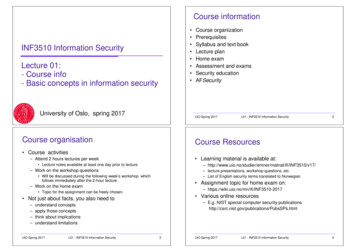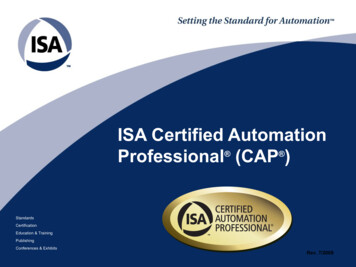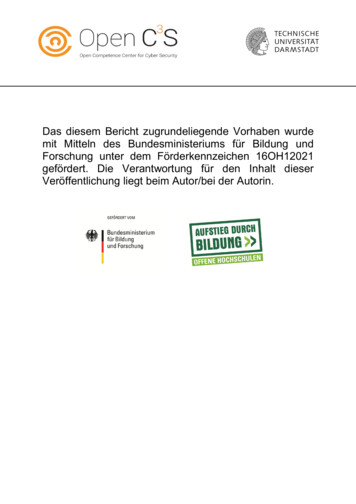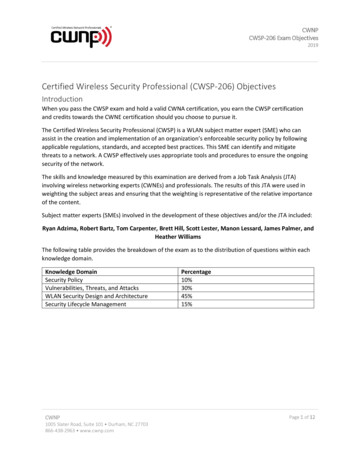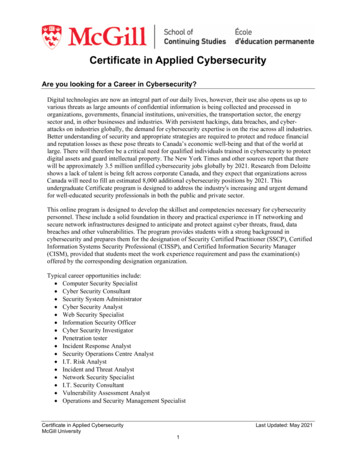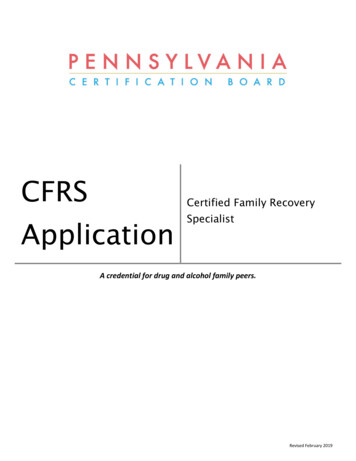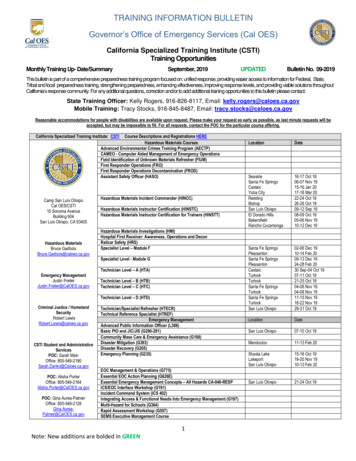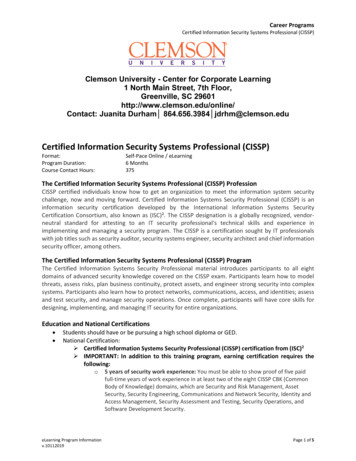
Transcription
Career ProgramsCertified Information Security Systems Professional (CISSP)Clemson University - Center for Corporate Learning1 North Main Street, 7th Floor,Greenville, SC 29601http://www.clemson.edu/online/Contact: Juanita Durham 864.656.3984 jdrhm@clemson.eduCertified Information Security Systems Professional (CISSP)Format:Program Duration:Course Contact Hours:Self-Pace Online / eLearning6 Months375The Certified Information Security Systems Professional (CISSP) ProfessionCISSP certified individuals know how to get an organization to meet the information system securitychallenge, now and moving forward. Certified Information Systems Security Professional (CISSP) is aninformation security certification developed by the International Information Systems SecurityCertification Consortium, also known as (ISC)². The CISSP designation is a globally recognized, vendorneutral standard for attesting to an IT security professional's technical skills and experience inimplementing and managing a security program. The CISSP is a certification sought by IT professionalswith job titles such as security auditor, security systems engineer, security architect and chief informationsecurity officer, among others.The Certified Information Security Systems Professional (CISSP) ProgramThe Certified Information Systems Security Professional material introduces participants to all eightdomains of advanced security knowledge covered on the CISSP exam. Participants learn how to modelthreats, assess risks, plan business continuity, protect assets, and engineer strong security into complexsystems. Participants also learn how to protect networks, communications, access, and identities; assessand test security, and manage security operations. Once complete, participants will have core skills fordesigning, implementing, and managing IT security for entire organizations.Education and National Certifications Students should have or be pursuing a high school diploma or GED.National Certification: Certified Information Systems Security Professional (CISSP) certification from (ISC)2 IMPORTANT: In addition to this training program, earning certification requires thefollowing:o 5 years of security work experience: You must be able to show proof of five paidfull-time years of work experience in at least two of the eight CISSP CBK (CommonBody of Knowledge) domains, which are Security and Risk Management, AssetSecurity, Security Engineering, Communications and Network Security, Identity andAccess Management, Security Assessment and Testing, Security Operations, andSoftware Development Security.eLearning Program Informationv.10112019Page 1 of 5
Career ProgramsCertified Information Security Systems Professional (CISSP)oGet endorsed to become a CISSP: Once you complete the CISSP exam, you'll haveto subscribe to the (ISC)2 Code of Ethics and complete an endorsement form tobecome a CISSP. The endorsement form must be signed by another (ISC)2 certifiedprofessional who verifies your professional work experience. You must submit thecompleted form within nine months of passing your exam to become fully certified,because passing the exam doesn't automatically grant you certification status.Program ObjectivesAt the conclusion of this program, students will be able to: Summarize DNS concepts and its components, and increasingly converged networks Security and Risk Management Asset Security Security Architecture and Engineering Communication and Network Security Identity and Access Management (IAM) Security Assessment and Testing Security Operations Software Development Security Becoming a CISSPCertified Information Security Systems Professional (CISSP) Detailed StudentObjectivesDOMAIN 1: SECURITY AND RISK MANAGEMENTSECURITY AND RISK MANAGEMENT PART 1 Examining Information Security Fundamentals Applying Security Governance Concepts – Part 1 Applying Security Ggoernance Concepts – Part 2 Designing and implementing governance documents Understadnign legal systems and related laws – Part 1 Understanding legal systems and related laws – Part 2 Implementing Personnel Security Implementing Third-Party SecuritySECURITY AND RISK MANAGEMENT PART 2 Understanding and Applying Threat Modeling Understanding & Implementing Risk Management Concepts Exploring Risk Assessment Methodologies Conducting a Quantitative Risk Assessment Conducting a Qualitative Risk Assessment Selecting Controls and Countermeasures Managing Supply Chain Risk Implementing Business Continuity Risk ManagementDOMAIN 2: ASSET SECURITYASSET SECURITYeLearning Program Informationv.10112019Page 2 of 5
Career ProgramsCertified Information Security Systems Professional (CISSP) Classifying AssetsManaging AssetsProtecting Data PrivacyEnsuring Appropriate Retention and DestructionDetermining Data Security ControlsDOMAIN 3: SECURITY ARCHITECTURE AND ENGINEERINGSECURITY ENGINEERING PART 1 Implementing Secure Design Principles Understanding Security Models Selecting Controls Based on Systems Security Evaluation Models Recognizing Information Systems Security Capabilities Assessing and Mitigating Security Architecture Vulnerabilitiies Assessing and Mitigating Cloud Vulnerabilities Assessing and Mitigating Web Vulnrabilties Assessing and Mitigating Mobile and Remote Computing VulnerabilitiesSECURITY ENGINEERING PART 2 Introducing Cryptography Applying Cryptography – Encryption Part 1 Applying Cryptography – Encryption Part 2 Applying Cryptography – Public Key Infrastructure Applying Cryptography – Hashing and Digital Signature Applying Cryptography – Crytography Protocols Applying Cryptography – Crypto Attacks Applying Secure Principles to Site and Facility Design Securing Information Processing Facilities and EquipmentDOMAIN 4: COMMUNICATION AND NETWORK SECURITYCOMMUNICATION AND NETWORK SECURITY Reviewing OSI and TCP/IP Models Understanding IP Convergence and Extensibility Securing Wireless Networks Using Cryptography to Maintain Communication Security Securing Network Access Securing Data Transmissions Securing Multimedia Collaboration Securing Virtual Private Networks Securing Endpoints Preventing and Migrating Network AttacksDOMAIN 5: IDENTITY AND ACCESS MANAGEMENT (IAM)IDENTITY AND ACCESS MANAGEMENT Understanding Access Control Fundamentas Examining Identification Schemes Understanding Authentication OptionseLearning Program Informationv.10112019Page 3 of 5
Career ProgramsCertified Information Security Systems Professional (CISSP) Understanding Authentication SystemsImplementing Access and Authorization CriteriaImplementing Access Control ModelsImplementing Access Control Techniques and TechnologiesIdentify and Access ProvisioningDOMAIN 6: SECURITY ASSESSMENT AND TESTINGSECURITY ASSESSMENT AND TESTING Testing and Examination (T&E) Overview Security Assessment Planning Conducting Security Examinations Conducting Security Testing – Target Identification Conducting Security Testing – Password Cracking Conducting Security Testing – Penetration Testing Understanding Log Analysis Implementing Information Security Continuous Monitoring (ISCM) Understanding Third-Party Audits and ExaminationDOMAIN 7: SECURITY OPERATIONSSECURITY OPERATIONS – PART 1 Managing Privileged Accounts Operating and Maintaining Firewalls and IDS/IPS Conducting Logging and Monitoring Activities Implementing and Supporting Vulnerability and Patch Management Implementing and Supporting Malware & Media Management Participating in the Configuration Management ProcessSECURITY OPERATIONS – PART 2 Managing System Resilience and Fault Tolerance Implementing Disaster recovery Processes Managing DR Plan Maintenance Understanding and Supporting Investigations Understanding Digital Forensics Supporting Incident Management Securing People and PlacesDOMAIN 8: SOFTWARE DEVELOPMENT SECURITYSOFTWARE DEVELOPMENT SECURITY Managing the Software Development Lifecycle Understanding Software Development Approaches, Models and Tools Understanding Source Code Security Issues Managing Database Security Assessing the Security Impact of Acquired SoftwareDOMAIN 9: BECOMING A CISSPPREPARING FOR THE EXAMeLearning Program Informationv.10112019Page 4 of 5
Career ProgramsCertified Information Security Systems Professional (CISSP) Security and Risk Managementt Domain: Review and Study RoadmapAsset Security Domain: Review and Study RoadmapSecurity Engineering Domain: Review and Study RoadmapCommunications and Network Security Domain: Review and Study RoadmapIdentify and Access Domain: Review and Study RoadmapSecuity Assessment and Testing Domain: Review and Study RoadmapSecurity Operations Domain: Review and Study RoadmapSecurity Development Security Domain: Review and Study RoadmapTaking the CISSP ExaminationeLearning Program Informationv.10112019Page 5 of 5
challenge, now and moving forward. Certified Information Systems Security Professional (CISSP) is an information security certification developed by the International Information Systems Security Certification Consortium, also known as (ISC)². The CISSP designation is a globally recognized, vendor-

